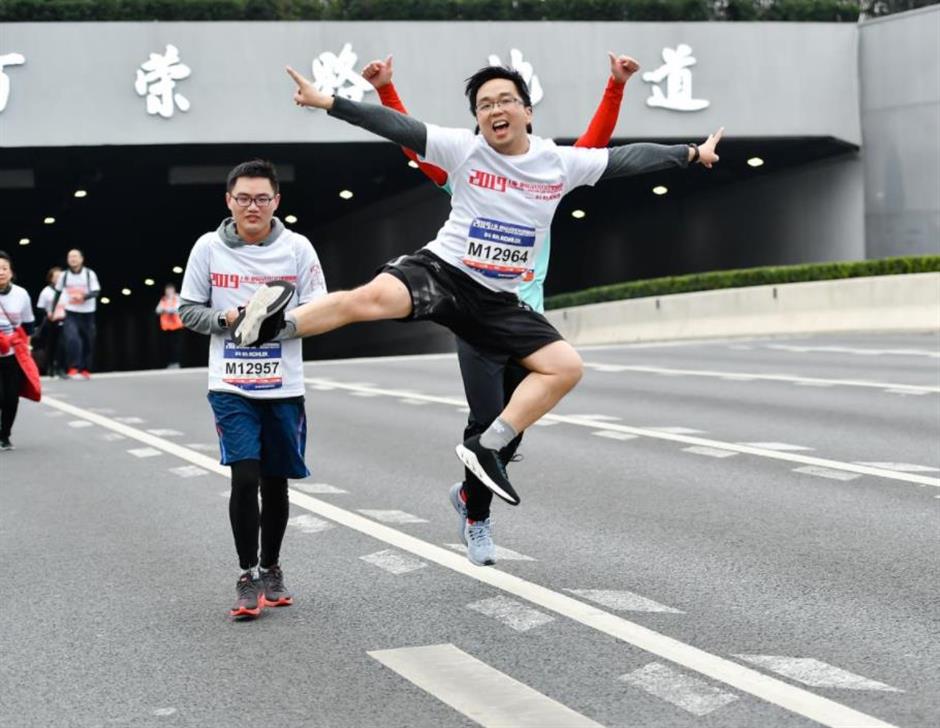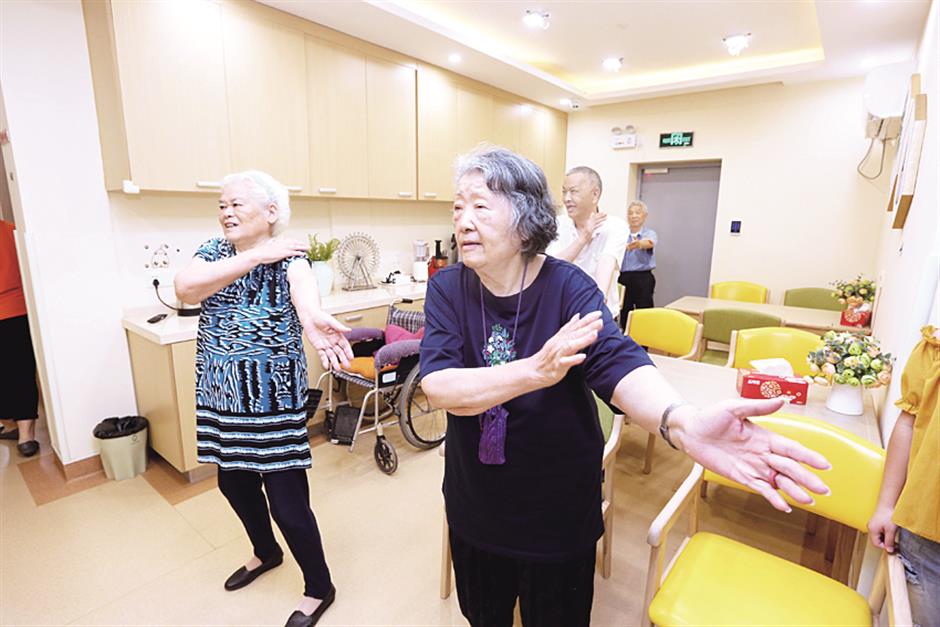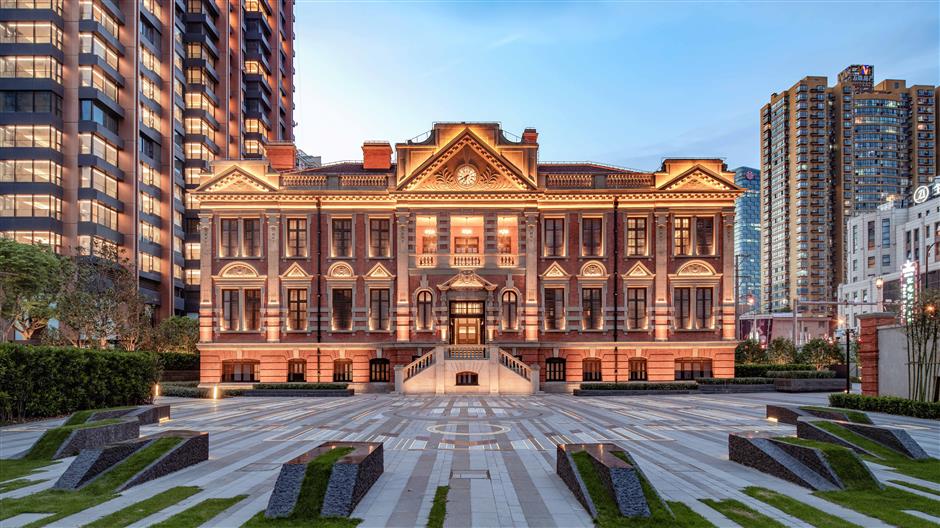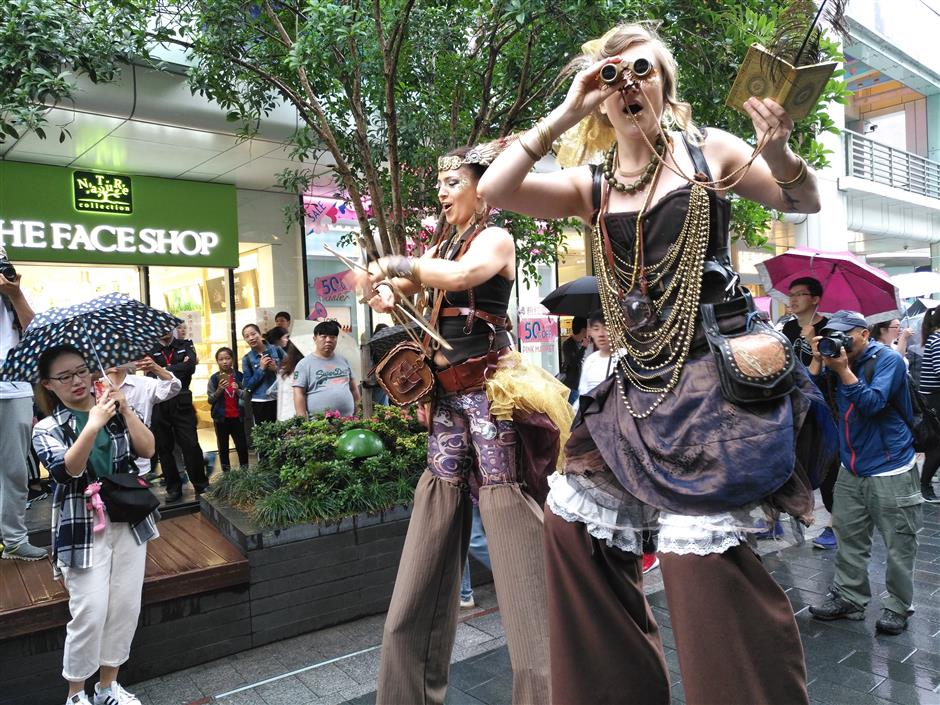A running start to 2019
Jing'an Keywords
Jing’an sits at the heart of Shanghai. It represents the essence of the history and culture of the city, home to century-old buildings, big-name attractions, glitzy retail malls and charming art galleries. Annual music and art events give the district a distinctive ambience. In this series, we showcase the highlights of Jing’an.
January Keywords
A running start to 2019


About 4,800 runners welcomed 2019 on a healthy note, participating in running events. About 3,500 runners finished the 10-kilometer race from Jing’an Park to Daning Park. The other 1,300 runners completed a 5-kilometer race held at Shanghai Railway Station. They ran past district landmarks like the commercial hub of Nanjing Road W. and the Hengfeng Road Bridge
Goals in 2019
This month, the district’s lawmakers and political advisers held their annual meetings, called by locals the “Two Sessions.” The meetings review progress in the year just ended and discuss the priority policies for the current year.
Housing renovation
In 2019, 1 million square meters of housing will be renovated.
Some 400 families will say goodbye to cramped living conditions with inadequate plumbing and toilet facilities.
Also, 50 elevators will be installed in old residential buildings five stories or higher. Most of the buildings were constructed at least 50 years ago, when elevators were still a luxury in China. The lack of elevators has made many elderly residents virtual prisoners in their own homes because they can’t negotiate stairs.
Environmental improvement
In 2019, 80,000 square meters of parkland, 15,000 square meters of vertical greenery and 2 kilometers of greenbelts will be added across the district, covering roadsides and riversides, neighborhoods and industrial parks.
Jing’an will convert 20 public restrooms into “smart toilets,” backed by computerized systems to monitor odors, hygiene and cleaning schedules. Toilet paper dispensers will be equipped with sensors embedded with facial recognition technology to cut down on paper waste.
Atop the toilets, rainwater collectors will trap water that can be used for local gardens. Solar panels will heat water for washing hands.
Jing’an will also build 10 24-hour public restrooms.
Waste sorting
In 2019, Jing’an will create 350 “model neighborhoods” to recognize their progress in sorting waste. Every day, 250 tons of wet waste will be processed and 48 tons of waste will be recycled.
River cleanup
The water quality of the Jiangchang and Zhongyang rivers will be upgraded to a level that nurtures fish and allows people to swim.
Fire prevention
Jing’an is dotted with old houses, many at risk of fire.
To provide more safety, the district will install 5,000 fire alarms as part of its “smart city” program. Once an alarm is triggered, local police, firefighters and neighborhood officials will be alerted immediately via an online system. The rosters of those on duty and the maintenance records of firefighting equipment will also be shown online.
Some 100 bike-parking sites will also be equipped with firefighting equipment in case an electric bike burns out when charging.
Elderly care
In 2019, an extra of 250 beds will be added to senior care homes across the district. A comprehensive senior care home will be built in a community, providing a variety of services such as daycare, medical treatment and rehabilitation nursing. Seniors will be able to watch movies, listen to informative talks and attend cultural activities.

Helping the needy
Jing’an will help 590 jobless young people find employment and support 800 people starting up their own businesses, including 480 university students and young people.
Education
Construction of a branch of Yuyao Road Kindergarten will be completed. Two cage soccer fields will be built in schools and coaches will be trained. Also, 500 “Love Summer Care” camps for primary school students will be opened during the two-month summer vacation to relieve the burden of working parents.
Medical care
In 2019, a traditional Chinese medicine hospital and a new dentistry will be built. Jing’an will organize six free medical consultations in communities and provide free colon cancer screening for 150,000 residents. Colon cancer has become the No.2 most prevalent cancer in Shanghai, with the incidence rate rising 4.2 percent every year.
Cultural facilities
Renovation of the Tianmu Road branch of Jing’an Library will be completed.
Restoration of the former site of the National Labor Union Secretariat will be completed and the exhibition hall will be renovated and upgraded.
Restoration of the 97-year-old Yuanli Pawnshop, the largest and best-preserved pawnshop in Shanghai, will be finished and operate as a museum.
Ten grassroots cultural service sites will be built in neighborhoods.
Jing’an will provide 160,000 5-yuan film tickets to residents, with subsidies provided by cinemas and the district government.
Sports facilities
A new public sports field, three jogging and walking paths, and 25 community-based fitness sites will be built. Lighting equipment at stadiums and sports fields in 82 schools that are open to the public will be renovated. Free physical checkups will be provided for 13,000 residents.
Food markets
Jing’an will renovate three wet markets. Ten sites providing cheap, healthy lunches for white-collar workers will be upgraded.
‘Two sessions’ voices
Lawmaker Liu Qing suggested capturing residents’ stories to preserve local culture.
Lawmaker Dong Jiyuan suggested venerated brands be linked to new technologies to better compete with international brands.
Lawmaker Li Lei suggested encouraging technology industries to set up offices in Shibei High Technology Park.
Lawmaker Zhu Jianfeng suggested upgrading services at grassroots healthcare centers to relieve the burden on comprehensive hospitals.
Lawmaker Zhu Yiping suggested fostering quality caregivers who can provide professional care to the elderly in their homes.
Political adviser Shi Yanjun suggested that high technology companies make their voices heard on the world stage.
Political adviser Wu Shujun suggested promoting waste sorting in primary schools
Political adviser Ni Keliang suggested organizing more cultural activities for senior citizens.

Achievements in 2018
Here is Jing’an’s track record in 2018.
Booming financial hub
In 2018, Jing’an collected tax revenue of 72.37 billion yuan, up 5.5 percent from 2017. Notably, more than half of the district’s tax revenues came from foreign companies.
In 2018, the district’s 17 major shopping malls achieved sales of 20.63 billion yuan, an increase of 22 percent. Six regional headquarters of multinational companies set up offices in Jing’an.
Our “smart city”
Jing’an is home to the Shanghai Data Exchange, China’s leading big data center that hands an average 30 million pieces of data every day. Jing’an has become an “experimental district” to spearhead Shanghai’s smart city comprehensive plan.
In January, Amazon’s Web Services subsidiary brought new blood to the “smart city,” cooperating with the district government to build Shanghai-Amazon AWS United Innovation Center in Shibei High Technology Park, where the date exchange is located.
The center will include a center where the latest technologies will be trialed before being applied to the “smart city” plan. It will also help to foster professionals in big data and set up international incubators in Jing’an.
In March, Linfen Road subdistrict offered a real-life prototype of a “smart city.”
It built in tens of thousands of digital sensors -- in restaurant kitchens for smoke detection, in sewers to monitor manhole-cover theft and in the beds of the elderly to track their vital signs.
Sensors automatically upload data to an analytics platform. Alerts will be triggered if “abnormal figures” appear.
“Many small retailers and restaurants don’t use electricity properly,” said Yu Linwei, a subdistrict official. “Several times, smoke sensors have alerted us to potential risks, and we were able to intervene before the situation escalated to fire. There are so many problems, like people living on high floors throwing trash off their balconies, drivers parking cars in banned areas and elderly people who live alone and suffer medical problems.”
The safety of seniors living alone – especially the 100 elderly who are 80 year or older -- has been a major concern in the subdistrict. Sensors have been installed in their complex, including one at a gate to ensure that they are back home safely and one is their living rooms to detect movement. A third sensor is installed under their beds to monitor vital signs and record how many times they wake up every night.
Seniors suffering from dementia are equipped with Bluetooth bracelets that connect with community sensors to alert officials if they get lost.
“It achieves 24-hour monitoring,” said Zhou Jun, director of Jing’an’s science and technology authority. “It eliminates barriers that restrict information to one department. Now the data are shared.”
This pioneer project is expected to be expanded to all of Jing’an in the near future.
Commercial makeover
In 2018, the district government released detailed plans to spruce up 11 backstreets that feed into bustling Nanjing Road W. Distinctive features for every one of them will be based on location, history and individual culture.
Backstreets are part of the city’s cultural DNA . Authorities said they should reflect the local lifestyle while meshing with concepts of modern retail and people-friendly public spaces.
Yuyuan Road will be renovated into a community of dessert bars, book cafes and workshops conducting classes in painting, flower arrangement and the tea ceremony.
Nanyang and Fengxian roads will attract trendsetters by opening boutique shops, designer brands, vintage stores and popular eateries.
Wujiang Road will turn from a food street to a place where the latest retail trends are showcased. Self-service stores, pop-up stores and other crossover projects will be introduced.
Jiangning Road will be redeveloped to rival New York’s Broadway or London’s West End.
Tongren Road is set to be the home of high-end galleries, museums and auction houses.
Weihai Road will be redeveloped as an incubator for digital media. Xikang Road will be an international sports neighborhood, and Taixing and Maoming roads have been designated nightlife areas.
Renovation Shaanxi Road N was completed in September 2018. The 230-meter section between Nanjing and Weihai roads is home to 17 shops selling venerated brands, including the 300-year-old Leiyunshang pharmacy and heritage-listed Longfeng Cheongsam.
The shops have retained their traditional charm while embracing modern retail concepts to keep pace with a highly competitive, rapidly changing marketplace. The stores offer personalized service to attract customers.
Protecting historical and cultural relics
In 2018, Jing’an completed the cataloguing of 631 heritage architectural sites that have yet to receive protected status. Information such as the age and style of each building were registered so that the buildings wouldn’t be demolished during urban renewal projects.
Some historical buildings have been renovated and given a new lease of life. They include the former offices of the Shanghai Chamber of Commerce, which reopened last June after seven years of renovation.
China’s first modern chamber of commerce was founded in February 1912. It assisted in efforts to draft China’s first business law and opened the nation’s first arbitration service. its first commodity exhibition hall, its first business library and the first retail mall selling diverse domestic merchandise.
“The chamber strove to drive the prosperity of the local business sector, along with supporting various patriotic campaigns,” said historian Jiang Yihua.
The three-story red-brick office building was in the style of Western classicism, featuring a symmetrical facade adorned by pediments above the gate and windows.
The centerpiece of the facade contains two Ionic pilasters, commonly seen in classical Greek temples. Running from the second to third floor, the pilasters hold up a giant pediment embodying the baroque style and an inlaid round clock.
Stone steps lead to the building’s main entrance. A colorful handcrafted mosaic floor adds vintage touches to the foyer, including a giant floral pattern based on a mandala-style design. Wooden stairways feature exquisite decoration.
The highlight of the structure is the two-story high conference hall, which can hold 800 people. It features an 18.3-meter-long ceiling dome, dark wood paneling on walls and corridors with ornate decoration and elegant railings.
Some years later, a giant gateway was erected on the south of the building. It was designed based on the Arch of Titus in Rome, featuring four pillars in the typical Corinthian style of ancient Greece.
After the chamber was shuttered by the Kuomintang government in 1929, it was variously used as a school and factory site. In the late 1950s, an electronics manufacturing factory moved in, inflicting major damage to the building. In recent years, construction on Metro lines and nearby skyscrapers caused further deterioration of the building.
It was a ruined and abandoned building when Ling Yingsong, who was in charge of the restoration work, first visited the site in March 2011.
“What I saw were just mottled bricks, tiled windows, mildewed walls and peeling ceilings,” he said.
Now, it has been restored to its former glory.
Improve living conditions
In 2018, more than 3,000 families benefited from the urban renewal projects, saying goodbye to old, cramped residences. One of the major projects was in Pengsan.
It is a typical old residential warren where thousands of people, many of them elderly, live in wretched conditions in decaying old buildings. The structures were built about 60 years ago without elevators and with shared toilets and kitchens. Two or three families shared one kitchen and as many as 10 shared a single toilet.
New apartment buildings will be erected to replace 11 decrepit structures. Demolition is now underway. Residents have moved out temporarily. They will move back in two to three years to enjoy life in their “new homes.
Besides major overhauls, many neighborhoods across the district have launched many “micro-renovation” projects.
Junked bikes littering neighborhoods are a big headache for residential committees, and also an eyesore. But in Yikangyuan community, the eyesore has been turned into eye-catching art installations.
Previously, piles of bikes in various states of disrepair were left tangled in corridors or lined up along walls. They took up public space and posed fire hazards.
Local officials collected abandoned bikes from residents and turned them into art installations. Children were invited to paint the bikes and draw on the walls where the bikes were to be placed. Currently, it has become a popular attraction among local residents.
Major events in 2018
March: Tulip festival
Millions of tulips in 45 different species came into full blossom in Daning Park last spring. The array included orange blossoms emitted a golden hue in sunlight, white blossoms appearing as delicate as porcelain, and hot pink blossoms that swayed in the wind like dainty young ladies.

May: Drama festival
Modern Drama Valley, Shanghai’s annual theatrical extravaganza, was held last May, presenting 17 productions from China, Russia, Lithuania, Poland, Australia, France, Britain and Japan. Fourteen of the plays were Shanghai debuts, and six were staged on the Chinese mainland for the first time.
Opening the festival was “Ordinary World,” adapted from the award-winning novel of the same name that portrays the lives and struggles of people in rural Shaanxi Province in the 1970s and 1980s.
A wide range of street theater performances were also staged by artists in popular commercial zones. They included magic shows, improvised mini-dramas, freestyle dancing and bubble shows. Also, giant puppets were brought to life on the streets. Both local residents and foreign visitors stopped to watch, expressing amazement at the street performances.

July: Party’s birthday
On July 1, the 97th anniversary of the founding of the Communist Party of China, nearly 4,000 people visited the Museum of the Second National Congress to pay tribute to the birthplace of the Party’s constitution.
It is one of the most popular “red” revolutionary sites in the city, receiving an average 3,000 visitors every day. It boasts China’s first Party constitution library, with booklets in different covers on display.

September: Sculpture festival
Some 87 pieces of sculptured works by 40 artists from 14 countries and regions were on display in the three-month 2018 Jing’an International Sculpture Project.
This giant upside-down truck sculpture, designed by Austrian artist Erwin Wurm, was the star of the show. It is part of well-known “One Minute Sculptures Series” that captivated the world during the Venice Biennale in 2017.

















